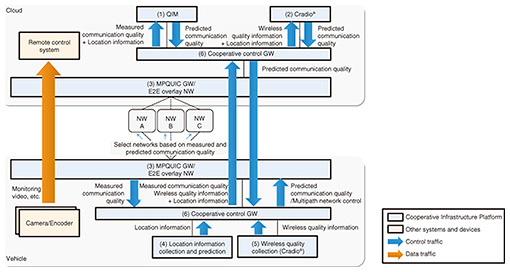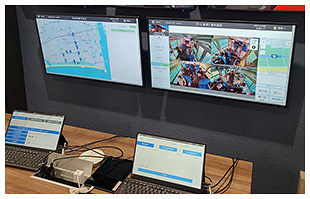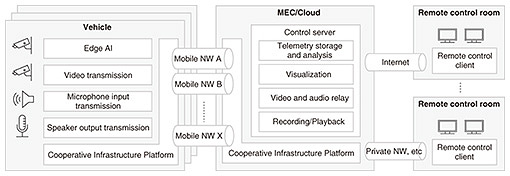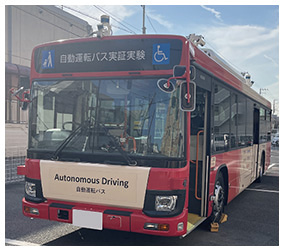 |
|||||
|
|
|||||
|
Regular Articles Vol. 23, No. 2, pp. 19–25, Feb. 2025. https://doi.org/10.53829/ntr202502ra1 Field Verification of Automated Driving Using Cooperative Infrastructure PlatformAbstractThis article introduces a field verification of automated driving using the Cooperative Infrastructure Platform being developed by NTT laboratories. The Cooperative Infrastructure Platform aims to ensure stable communication in remote monitoring and improve the safety of automated driving. This platform is also being used as the communication function of the remote control system for automated driving developed by NTT DOCOMO, and field tests are being conducted in collaboration with NTT DOCOMO. Keywords: IOWN, cyber-physical systems, remote monitoring of automated driving 1. Issues with wireless communications in remote control systems for automated drivingIn April 2023, the Road Traffic Law was amended to lift the ban on Level 4 automated driving (fully automated driving that does not require a driver under specific conditions) in Japan, which allows driverless automated driving on public roads. Automated driving is expected to bring various benefits to society, including resolving the driver shortage, ensuring transportation for the elderly and disabled, reducing traffic accidents, and improving the efficiency of logistics. To safely operate Level 4 automated driving, however, several conditions are mandatory. One of the most important of these is remote monitoring via video by an operator. This is an essential element for enabling operators to monitor the vehicle’s operating status in real time and respond to any problems as necessary. Video monitoring requires data transmission via mobile communications, and the major challenge is to achieve high-capacity communications with a high level of reliability. One of the technical issues that needs to be addressed is that the communication environment is constantly changing due to the vehicle’s movement. The quality of communication is affected by factors, such as the attenuation of radio waves by obstructions such as high-rise buildings and overhead structures, and congestion in the network caused by an increase in the number of users in the area. As the effects of these factors fluctuate due to the movement of vehicles, the quality of communication also fluctuates. When communication becomes unstable, there is a risk that the video may be interrupted or delayed; thus, the operator may not be able to respond to the vehicle at the appropriate time. To address these issues, NTT laboratories are developing the Cooperative Infrastructure Platform to achieve stable mobile communications. This platform aims to ensure stable data transmission by linking terminals, networks, and the cloud and enable flexible responses to changes in the communication environment. This will enable operators to grasp the status of vehicles in real time and support safe and efficient automated driving. 2. Cooperative Infrastructure PlatformThe Cooperative Infrastructure Platform is a fundamental technology aimed at accommodating mission-critical cyber-physical system (CPS) services [1]. In this article, we introduce the elemental technologies that contribute to the high reliability of communication between vehicles and the cloud, which is particularly required for remote monitoring of automated driving. CPS services require extremely high reliability and real-time performance because any delay in control could have fatal consequences. However, when the surrounding environment is constantly changing, such as when driving a vehicle, it is difficult to maintain high reliability and real-time performance because the quality of communication fluctuates greatly due to various external factors. One possible solution is to measure the communication quality on the vehicle side and switch the communication line when quality degradation is detected, but if quality degradation occurs suddenly, it may not be possible to detect it in time and switch the line, and communication may be cut off. In contrast, the Cooperative Infrastructure Platform continuously predicts communication quality and avoids using lines where quality degradation is predicted in advance, achieving highly reliable communication even in environments where sudden quality degradation occurs. As shown in Fig. 1, the Cooperative Infrastructure Platform is composed of multiple elemental technologies deployed on the vehicle and cloud sides, i.e., the (1) Quality Index Map (QIM) and (2) Cradio® (multi-radio proactive control technology), both of which predict communication quality; (3) Multi-path QUIC gateway (MPQUIC GW), which allocates multiple lines on a packet-by-packet basis based on the predicted values, and the end-to-end overlay network (E2E overlay NW), which allocates multiple lines on a flow-by-flow basis; (4) location information collection and prediction function and (5) wireless quality collection function, both of which collect the information necessary for prediction; and (6) cooperative control GW, which is responsible for the distribution of control information. These technologies work in close coordination.
The QIM is a technology that learns communication quality on the basis of actual service communication (such as monitoring video) on a specific date and time and area basis then uses the learning results to estimate communication quality. The QIM achieves high-precision quality estimation that incorporates the latest changes in the surrounding environment without the need for probe packets for learning and without putting pressure on the available bandwidth. Cradio® is a group of wireless technologies for providing a natural communication environment that does not make users aware of the type of wireless network used by adapting to the ever-changing user requirements and radio wave conditions and is composed of three groups of technologies: understanding, prediction, and control. For the Cooperative Infrastructure Platform, we use Cradio® prediction technology to predict the quality of wireless communication in a future driving location using information collected from various wireless communication devices and machine learning. The MPQUIC GW is a device that transparently transfers packets using the stream and datagram frames of a multipath extension to the QUIC protocol [2], the latest technology currently being standardized, and provides various network control functions for highly reliable, real-time packet transmission, including packet-based line allocation and aggregation based on predicted and actual communication quality values. The Cooperative Infrastructure Platform thus achieves highly reliable, real-time communication even in environments where rapid quality degradation occurs through advanced coordination such as high-precision quality prediction and advanced network control based on quality prediction. 3. Application of the Cooperative Infrastructure Platform to remote control systemsA remote control system for automated driving is a system that ensures the safe and efficient operation of automated driving vehicles even when the driver is not present. This system monitors the status of the vehicle in real time and responds remotely as necessary, enabling rapid response even in the event of an abnormality. 3.1 Remote control operationsRemote control operations are carried out for crew duties other than vehicle operation. There are two main aspects to these operations. 1) Passenger safety and support: It is important to ensure passenger safety and provide support as necessary. A remote control system is used to respond to accidents, deal with suspicious persons on board, check seating, and respond to passenger inquiries. This ensures that the safety of the vehicle is maintained even when the driver is not present, and that passengers feel secure. 2) Operation management: Operation management tasks, such as vehicle allocation, punctuality management, and fare checking, are also carried out remotely. These tasks are managed appropriately to ensure that the automated vehicles run smoothly, and support is provided to prevent delays in operation. In some cases, remote assistance (SAE J3016) is used to provide support to the automated driving system from an operator. At construction sites, for example, the operator provides “guidance” on the driving path, etc., on the basis of requests from the automated driving system. While the automated driving system installed in the autonomous vehicle is responsible for the dynamic driving operations of accelerating, stopping, and turning, remote monitoring enables safe operation of driverless autonomous vehicles. 3.2 Remote control systemNTT DOCOMO is developing a remote control system that supports Level 4 automated driving (Fig. 2). This system is made up of an autonomous vehicle, control server on multi-access edge computing (MEC) and the cloud, and a control client at a remote control center. It also has various processing functions on the remote control server to support remote control operations such as transmitting video, audio, and telemetry between the vehicle and remote control room (Fig. 3). 1) Autonomous vehicle: The vehicle is equipped with cameras, microphones, and sensors, and the data from them are sent to the control server in real time. The vehicle is also equipped with edge artificial intelligence (AI) functions for detecting abnormalities, and if an abnormality is detected, the client at the remote control center is immediately notified via the control server. This system enables a quick response in the event of an abnormality. The vehicle runs autonomously, but if it requires assistance, it can also receive instructions remotely. 2) Control server: The control server relays and processes the video, audio, and telemetry data sent from the autonomous vehicle. It has functions for storing and analyzing telemetry data and for visualizing the data, so it can determine the situation in real time. This enables the vehicle to be operated while automatically checking the safety of the interior, and in the event of an abnormality, prompt analysis and alert transmission can be carried out, enabling a quick response. 3) Control client: The operators at the remote control center constantly monitor the status of the vehicles via the control client. Based on the video and audio received in real time, if an abnormality or emergency situation occurs, it is possible to remotely stop the vehicle or communicate with the passengers via audio. This makes it possible to operate safely even when not on site.
3.3 Communication requirements for remote control systemsReliability and real-time performance are extremely important for communication requirements for remote control systems. The following requirements must be met. 1) Real-time performance: Video, audio, and telemetry data must be transmitted in real time without delay. For example, vehicle location information and status data must be updated almost immediately, and a quick response is required, particularly in emergency situations. 2) Reliability: Video, audio, and telemetry data must be transmitted stably without interruption. There must be no loss or delay of data, and a system that immediately notifies the user of any abnormalities is required. A system that can quickly restore communication in the event of a disruption is also necessary. 3.4 Application of the Cooperative Infrastructure PlatformNTT DOCOMO’s remote control system for automated driving experimentally uses the Cooperative Infrastructure Platform for communication between vehicles and the control server to meet communication requirements (Fig. 3). Using this platform ensures stable communication between vehicles and the control server without interruption. This enables real-time data transmission and ensures the safe and efficient operation of automated vehicles through an automated driving remote control system with stable transmission of vehicle status, location information, video, and audio data. 4. Automated driving field verificationThe remote control system using the Cooperative Infrastructure Platform was used in the automated driving field verification in Hiratsuka City, Kanagawa Prefecture, from January 22 to February 2, 2024. The verification test was conducted with the aim of achieving Level 4 automated driving, and NTT DOCOMO provided the remote control system. Cameras were installed inside the bus, and the images captured with these cameras were sent to a remote monitoring room via the Cooperative Infrastructure Platform. By monitoring the continuous and stable images, the remote monitoring room can check the status of the vehicle and ensure safety even when there is no driver. The vehicle used in the verification test and the equipment installed in the vehicle are shown in Fig. 4.
Without the Cooperative Infrastructure Platform, there may be long periods of disruption depending on the location, time of day, and other circumstances. In the remote control system with the Cooperative Infrastructure Platform, we confirmed that stable video can be transmitted without long periods of disruption by proactively and reactively selecting lines with good network quality. We plan to develop the technologies of the Cooperative Infrastructure Platform based on the experience and issues identified in the field verification. 5. Future developmentsThis article introduced a field verification of automated driving using the Cooperative Infrastructure Platform being developed by NTT laboratories. The platform flexibly responds to fluctuations in communication quality and achieves stable data transmission in remote monitoring of automated vehicles. In collaboration with NTT DOCOMO, we used this platform in a field test in February 2024 and confirmed that the platform improved the safety and reliability of automated vehicles. We will continue to conduct further verification tests and improve the platform to achieve remote control services for Level 4 automated driving. We will also aim to develop the platform for other use cases that require highly reliable wireless communication, such as drones and smart factories, as well as develop new elemental technologies. References
|
|||||























